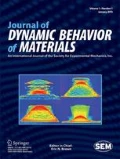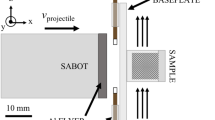Abstract
Pyrometry is one of the most prevalent techniques for measuring temperature in shock physics experiments. However, the challenges of applying pyrometry in such highly dynamic environments produces multiple sources of uncertainty that require investigation. An outstanding question is the degree of agreement between different pyrometers and different experiments. Here we report a series of novel plate impact experiments with simultaneous thermal radiance measurements using three different multi-wavelength optical pyrometry systems, each with different spatial and temporal resolutions, on samples shocked to identical states. We compare the temperatures measured by each system and their associated uncertainties using a number of emissivity assumptions. The results shown that the measurements from all three systems agree within uncertainty. Some non-thermal light contamination was observed despite a number of prevention measures.
















Similar content being viewed by others
References
Ota T, Chapman D, Eakins D (2017) Monte-Carlo modelling to determine optimum filter choives for sub-microsecond optical pyrometry. Rev Sci Instrum 88:04492
Chrzanowski K, Szulim M (1999) Errors of temperature measurement with multiband infrared systems. Appl Opt 38:1998–2006
Fu T, Cheng X, Fan X, Ding J (2004) The analysis of optimization criteria for multi-band pyrometry. Metrologia 41:305–313
Seifter A, AW O (2007) About the proper wavelength for pyrometry on shock physics experiments. Int J Thermophys 28:934–946
Khan M, Allemand C, Eagar T (1991) Non-contact temperature measurement. I. Interpolation based techniques. Rev Sci Instrum 62:392–402
La Lone BM, Stevens GD, Turley WD, Holtkamp DB, Iverson AJ, Hixson RS, Veeser LR (2013) Release path temperatures of shock-compressed tin from dynamic reflectance and radiance measurements. J Appl Phys 114:063506
Turley WD, Holtkamp DB, Veeser LR, Stevens GD, Marshall BR, Corrow SARB, Stone JB, Young JA, Grover M (2011) Infrared emissivity of tin upon release of a 25 GPa shock into a lithium flouride window. J Appl Phys 110:103510
Ota T, Chapman D, Richley J, Eakins D (2017) Initial results from a simultaneous pyrometry and reflectivity diagnostic. Proceedings of Shock Compression of Condensed Matter 2017, Awaiting publication, 2017
Seifter A, Stewart ST, Furlanetto MR, Kennedy GB, Payton JR, Obst AW (2006) Post‐shock temperature measurements of aluminum. In AIP Conference Proceedings, vol 845, no. 1, pp 139–142) AIP
Strand OT, Goosman DR, Martinez C, WhitworthW TL, Kuhlow W (2006) Compact system for high-speed velocimetry using heterodyne techniques. Rev Sci Instrum 77:083108
Partouche-Sebban D, Pelissier J, Abeyta F, Anderson W, Byers M, Dennis-Koller D, Esparza J, Hixson R, Holtkamp D, Jensen B, King J, Rodriguez P, Shampine D, Stone J, Westley D, Borror S, Krushwitz D (2005) Measurement of the shock-heated melt curve of lead using pyrometry. J Appl Phys 97:043521
Hereil P, Mabire C (2001) Temperature measurment of tin under shock compression. Proc Shock Compress Condens Matter 2001:1235–1238
Forbes J (2012) Shock Wave Compression of Condensed Matter. Springer-Verlag, Berlin Heidelberg
S. Marsh, LASL Shock Hugoniot Data, University of California, 1980.
Cox GA, Christie MA (2015) Fiting a multiphase equation of state with swarm intelligence. J Phys 27:405201
Turley WD, Stevens GD, Capelle GA, Grover M, Holtkamp DB, LaLone BM, Veeser LR (2013) Luminescence from edge fracture in shocked lithium flouride crystals. J Appl Phys 113:113506
Haslam JJ (2015) “Silicone Tungsten Procedure” LLNL Report LLNL-MI-676695
Partouche-Sebban D, Holtkamp DB, Pélissier JL, Taboury J, Rouyer A (2002) An investigation of shock induced temperature rise and melting of bismuth using high-speed optical pyrometry. Shock Waves 11:385–392
Golovashkin AI, Motulevich GP (1964) Optical and electrical properties of tin. J Exp Theor Phys 19(2):301
Hartsfield T, Iverson A, Baldwin J (2018) Reflectance determination of optical spectral emmisivity of metal surfaces at ambient conditions. J Appl Phys 124:105107
Acknowledgements
The authors would like to thank Dave Pitman and Robert Denning for operating the gun facility. The AWE personnel would like to thank Tony Gallagher for technical drawing support and Neil Holmes for input on the impedance-matching slurry. T.O would like to thank Antony Glauser for helpful discussions on the application of probability density functions to pyrometry data. D.E.E., and D.J.C., thank Imperial College London, AWE, and the University of Oxford for their support. D.J.C also acknowledges the Engineering and Physical Sciences Research Council (EPSRC) for support through a Knowledge Transfer Secondment (KTS). Support for DEE provided by the Defence Science and Technology Laboratory (DSTL) is also gratefully acknowledged. UK Ministry of Defence © Crown Owned Copyright 2019/AWE.
Author information
Authors and Affiliations
Corresponding author
Additional information
Publisher's Note
Springer Nature remains neutral with regard to jurisdictional claims in published maps and institutional affiliations.
Appendix 1
Appendix 1
During the analysis presented here, an uncertainty in reflectivity in percentage terms is used. It is useful to discuss how uncertainty in reflectivity is translated to emissivity uncertainty.
In fixed uncertainties, because reflectivity and emissivity are complementary, see Eq. 2, the uncertainties are equal but opposite,
where Δ denotes an absolute uncertainty. However, if proportional errors are defined such that,
where δ denotes proportional uncertainty, the relation is different. Rearranging the above expressions,
This expression can be used to determine,
Thus a 10% error in reflectivity on a baseline reflectivity of 0.9 will give a proportional emissivity error of 90%.
Rights and permissions
About this article
Cite this article
Ota, T.A., Amott, R., Carlson, C.A. et al. Comparison of Simultaneous Shock Temperature Measurements from Three Different Pyrometry Systems. J. dynamic behavior mater. 5, 396–408 (2019). https://doi.org/10.1007/s40870-019-00201-2
Received:
Accepted:
Published:
Issue Date:
DOI: https://doi.org/10.1007/s40870-019-00201-2




